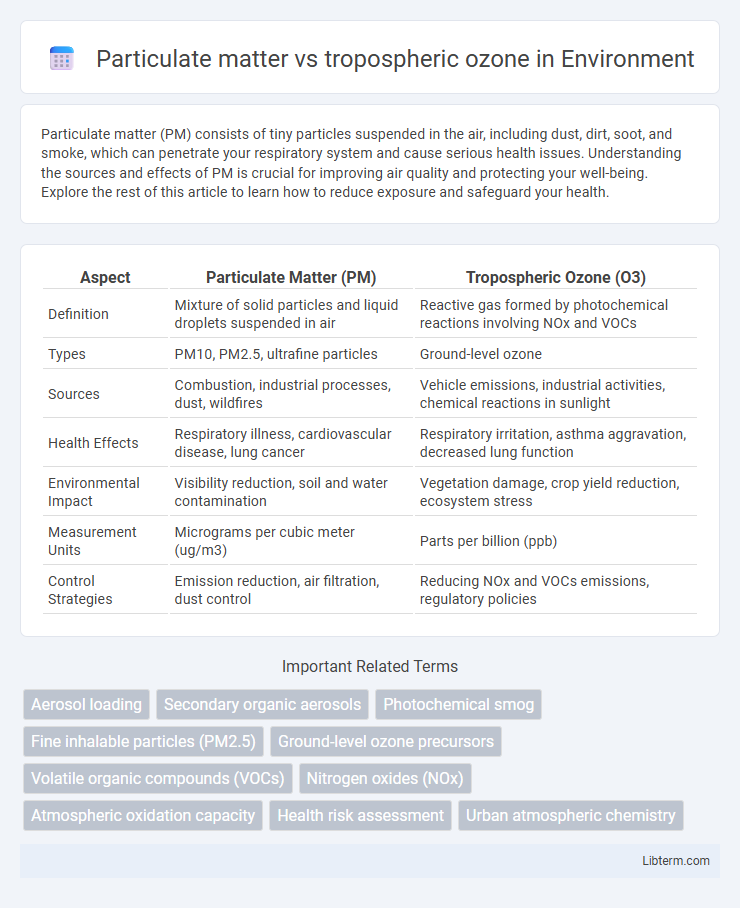Particulate matter (PM) consists of tiny particles suspended in the air, including dust, dirt, soot, and smoke, which can penetrate your respiratory system and cause serious health issues. Understanding the sources and effects of PM is crucial for improving air quality and protecting your well-being. Explore the rest of this article to learn how to reduce exposure and safeguard your health.
Table of Comparison
| Aspect | Particulate Matter (PM) | Tropospheric Ozone (O3) |
|---|---|---|
| Definition | Mixture of solid particles and liquid droplets suspended in air | Reactive gas formed by photochemical reactions involving NOx and VOCs |
| Types | PM10, PM2.5, ultrafine particles | Ground-level ozone |
| Sources | Combustion, industrial processes, dust, wildfires | Vehicle emissions, industrial activities, chemical reactions in sunlight |
| Health Effects | Respiratory illness, cardiovascular disease, lung cancer | Respiratory irritation, asthma aggravation, decreased lung function |
| Environmental Impact | Visibility reduction, soil and water contamination | Vegetation damage, crop yield reduction, ecosystem stress |
| Measurement Units | Micrograms per cubic meter (ug/m3) | Parts per billion (ppb) |
| Control Strategies | Emission reduction, air filtration, dust control | Reducing NOx and VOCs emissions, regulatory policies |
Introduction to Particulate Matter and Tropospheric Ozone
Particulate matter (PM) consists of microscopic particles suspended in the air, originating from sources such as vehicle emissions, industrial processes, and natural activities like wildfires. Tropospheric ozone (O3) is a secondary pollutant formed by photochemical reactions between nitrogen oxides (NOx) and volatile organic compounds (VOCs) under sunlight. Both PM and tropospheric ozone significantly impact air quality and human health by contributing to respiratory and cardiovascular diseases.
Chemical Composition and Formation
Particulate matter consists of a complex mixture of solid and liquid particles, including organic compounds, metals, sulfates, nitrates, and elemental carbon, formed from combustion processes, atmospheric reactions, and mechanical activities. Tropospheric ozone is a secondary pollutant generated through photochemical reactions involving nitrogen oxides (NOx) and volatile organic compounds (VOCs) under sunlight. The chemical formation of particulate matter often involves both primary emissions and secondary atmospheric reactions, while tropospheric ozone strictly results from photochemical oxidation processes in the lower atmosphere.
Primary Sources and Emission Pathways
Particulate matter (PM) primarily originates from combustion processes such as vehicle exhaust, industrial emissions, and biomass burning, releasing solid and liquid particles directly into the atmosphere. Tropospheric ozone forms secondarily through photochemical reactions involving precursors like nitrogen oxides (NOx) and volatile organic compounds (VOCs) emitted from sources such as power plants, automobiles, and vegetation. While particulate matter deposition occurs near emission sites, ozone formation depends on sunlight-driven chemical pathways and can impact air quality over regional scales.
Differences in Atmospheric Behavior
Particulate matter (PM) consists of solid and liquid particles suspended in the air, exhibiting localized deposition patterns influenced by gravity and precipitation, whereas tropospheric ozone is a reactive gas formed through photochemical reactions involving nitrogen oxides and volatile organic compounds, capable of widespread distribution due to its gaseous state. PM often settles near emission sources, affecting air quality on a regional scale, while tropospheric ozone can travel long distances, impacting air quality over larger geographical areas. Differing atmospheric lifetimes also affect their behavior: PM can remain in the atmosphere for hours to days, whereas tropospheric ozone persists for several days to weeks under favorable meteorological conditions.
Health Impacts of Particulate Matter vs Tropospheric Ozone
Particulate matter (PM), especially PM2.5, penetrates deep into the lungs and bloodstream, causing respiratory issues, cardiovascular diseases, and premature mortality. Tropospheric ozone irritates the respiratory system, reduces lung function, and exacerbates asthma and other chronic respiratory conditions. Both pollutants significantly increase hospital admissions and mortality rates, with PM generally posing a higher risk due to its ability to carry toxic substances deep into the respiratory tract.
Environmental and Climate Consequences
Particulate matter (PM) and tropospheric ozone both contribute significantly to air pollution but differ in their environmental and climate impacts. PM directly affects air quality by reducing visibility and harming respiratory health, while also influencing climate by altering the Earth's radiative balance through scattering and absorbing sunlight. Tropospheric ozone acts as a potent greenhouse gas, intensifying global warming, and damages vegetation by impairing photosynthesis, leading to reduced carbon sequestration and ecosystem productivity.
Monitoring and Measurement Techniques
Particulate matter (PM) monitoring utilizes gravimetric methods, beta attenuation monitors, and optical sensors like nephelometers to quantify particle concentration and size distribution. Tropospheric ozone measurement relies on ultraviolet photometry and differential optical absorption spectroscopy (DOAS) for high-precision detection of ozone concentration in ambient air. Advanced remote sensing technologies, including LIDAR for PM and satellite-based sensors for ozone, provide spatial and temporal resolution critical for comprehensive air quality assessment.
Regulatory Standards and Guidelines
Regulatory standards for particulate matter (PM2.5 and PM10) set by agencies like the EPA enforce strict limits to reduce health risks from inhalable particles, with annual PM2.5 concentrations capped at 12 ug/m3. Tropospheric ozone regulations focus on limiting ozone precursors such as NOx and VOCs, maintaining maximum 8-hour average concentrations below 70 ppb to lower respiratory issues. Comprehensive air quality guidelines by WHO emphasize controlling both pollutants due to their combined impact on cardiovascular and respiratory health.
Mitigation Strategies and Policy Approaches
Mitigation strategies for particulate matter (PM) prioritize emission reductions from industrial sources, vehicle exhaust, and biomass burning through stricter regulations and adoption of cleaner technologies. Tropospheric ozone control relies on reducing precursors like nitrogen oxides (NOx) and volatile organic compounds (VOCs) via policies targeting transportation, energy production, and urban planning. Integrated air quality management frameworks combine real-time monitoring, emission inventories, and public health guidelines to optimize policy effectiveness against both PM and ozone pollution.
Future Challenges and Research Directions
Future challenges in addressing particulate matter and tropospheric ozone include accurately predicting their interactions under changing climate conditions and urbanization trends. Research directions emphasize developing advanced atmospheric models to capture the nonlinear chemistry and transport processes affecting both pollutants. Enhancing real-time monitoring networks and integrating satellite data will improve understanding of spatiotemporal variations critical for effective mitigation policies.
Particulate matter Infographic

 libterm.com
libterm.com